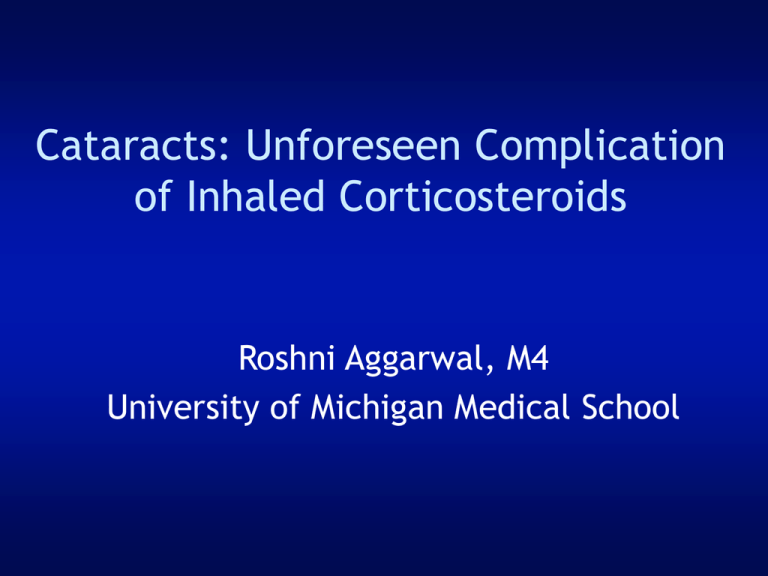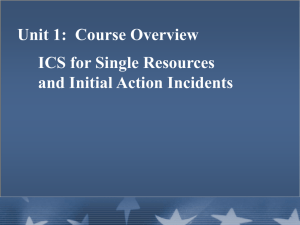
Cataracts: Unforeseen Complication
of Inhaled Corticosteroids
Roshni Aggarwal, M4
University of Michigan Medical School
Inhaled Corticosteroids (ICS)
Standard-of-care controller medication for asthma
Also widely used in treatment of COPD
Blocks multiple inflammatory pathways involved in the
pathogenesis of asthma
Currently available ICS include:
- beclomethasone dipropionate
- budesonide
- fluticasone propionate
- mometasone furoate
- triamcinolone acetonide
Indications for ICS in Asthmatics
Based on stepwise approach to management of asthma
ICS is first-line treatment for asthma in most stages
Stage
STEP 1
Mild intermittent
STEP 2
Mild persistent
STEP 3
Moderate persistent
STEP 4
Severe persistent
Daily Medications Required to Maintain Long-term
Control (preferred treatment only)
No daily medications needed
*ICS recommended for acute exacerbations
Low-dose ICS
Medium-dose ICS and long-acting β2 agonist
High-dose ICS and long-acting β2 agonist (and if needed,
corticosteroid tablet or syrup long-term)
National Asthma Education and Prevention Program Expert Panel Report Guidelines for the Diagnosis and Management of Asthma- Update 2002
Inhalation as a Novel Drug Delivery Method
Inhalation permits delivery of steroid in high concentration to target
sites in lung and minimizes amount of drug reaching systemic
circulation
Initially physicians hypothesized that this form of drug delivery might
entirely eliminate systemic side effects of ICS
However, this has not been confirmed by clinical trials or experience
Mechanism of ICS Entry into Systemic Circulation
All types of ICS have the potential to cause systemic side effects
ICS vary in terms of oral bioavailability, % drug deposition in lung, % first-pass
hepatic inactivation etc. (factors that influence amount of drug reaching systemic
circulation)
Rossi et al. Pulm Pharm & Therap 2007;20:23-35
Possible Systemic Side Effects of ICS
Based on known systemic side effects of oral corticosteroids:
HPA-axis suppression
Decrease in growth velocity and leg growth in children
Decrease in bone mineral density
Bone fractures
Osteoporosis
Skin thinning and bruising
Glaucoma
Cataracts
Link Between Corticosteroids and Cataracts
Use of systemic corticosteroids is established risk factor for
development of posterior subcapsular cataracts (PSC)
- prevalence of PSC 0-54% (mean 9%) based on meta-analysis by
Gallant et al. (1986) of 9 studies involving 343 asthmatics treated
with oral corticosteroids
Case report by Kewley (1980) first suggested that ICS may
also lead to development of cataracts
- case reports often confounded by previous exposure of asthmatic
patients to oral corticosteroids
So do we have the answers to these questions…
What is the risk of cataract development secondary to ICS?
What is the effect of dose and/or duration of ICS use?
How does this risk vary with age?
How do ICS compare with oral corticosteroids in terms of risk
of cataract?
Let’s look at the results of four retrospective studies…
1 - The Blue Mountains Eye Study
Community-based cross-sectional study in Blue Mountains, Australia
Recruited 3,654 people (49-97 years old)
Questionnaire used to collect information regarding steroid use,
including:
- current or prior use of ICS, including puffs per week and duration
- current or prior use of corticosteroids, including dosage and duration
Ophthalmologic exams performed on each patient to record
presence, type, and severity of cataracts
Cumming et al. Use of inhaled corticosteroids and the risk of cataracts. NEJM 1997;337(1):8-14.
BMES Patient Population
Of 3,313 subjects who provided information about corticosteroid use:
3%
7%
5%
Systemic and inhaled
corticosteroids
ICS only
Systemic corticosteroids only
85%
None
370 subjects used ICS alone or in combination with oral steroids (164
currently, 206 previously)
Subjects matched with regards to other potential risk factors for
cataracts (age, sex, DM, HTN, smoking history, sun damage)
Increased Prevalence of Cataracts Among ICS Users
1. Relative Prevalence of Cataracts Secondary to ICS Use (past and present)*
Type of cataract
Relative prevalence
95% CI
Posterior subcapsular
1.9
1.3-2.8
Nuclear
1.5
1.2-1.9
Cortical
1.1
0.9-1.3
2. Relative Prevalence of Cataracts Secondary to Current ICS Use Only*
Type of cataract
Relative prevalence
95% CI
Posterior subcapsular
2.6
1.7-4.0
Nuclear
1.5
1.1-2.0
Cortical
1.4
1.1-1.7
* All trends remained the same when subjects with current or prior use of systemic corticosteroids were
removed from the analysis. Relative prevalence of PSC secondary to current ICS use increased to 3.2 (95%
CI 1.7-6.1) in that model.
Dose-Response Relation Between Beclomethasone and Cataracts
3. Relative Prevalence of PSC With Increasing Weekly Beclomethasone Dose
Weekly dose of beclomethasone
(among all users)
Relative prevalence PSC
(p<0.001 for trend)
95% CI
≤14 puffs
1.3
0.6-2.8
15-28 puffs
2.1
1.1-3.9
>28 puffs
3.1
1.7-5.7
4. Relative Prevalence of PSC With Increasing Lifetime Beclomethasone Dose*
Lifetime dose of beclomethasone
(current users only)
Relative prevalence PSC
(p<0.001 for trend)
95% CI
<1000 mg
2.5
1.1-5.8
1000-1999 mg
5.4
2.0-14.7
≥ 2000 mg
5.5
2.3-13.0
* This dose-response relation became less evident (p=0.06) in the model restricted to subjects with no
current or prior use of systemic corticosteroids.
Key Findings of Blue Mountain Eye Study
ICS use associated with increased prevalence of PSC and nuclear
cataracts (even after controlling for the use of systemic
corticosteroids)
Results consistent with known relation between use of systemic
corticosteroids and presence of PSC
Possible dose-response relation between beclomethasone and PSC
(though may have been influenced by confounding use of systemic
corticosteroids)
2 - The RAMQ Database Study
Case-control study
Utilized Quebec’s universal health insurance plan database (RAMQ)
Enrolled 3,677 patients ≥70 years old with cataract extraction between 1992
and 1994
Randomly selected 21,868 controls from patients without diagnosis of
cataract and matched them to cases
Excluded patients with systemic steroid treatment
Adjusted for age, sex, DM, HTN, glaucoma, ophthalmic steroids, and #
physician claims for services
• Garbe et al. Association of inhaled corticosteroid use with cataract extraction in elderly patients. JAMA 1998;280(6):539-543.
Increased Risk of Cataracts with Prolonged ICS Use
Odds Ratio of Cataract Extraction According to Cumulative Treatment Duration
with ICS (excluding patients with oral steroid use)
Cumulative Treatment
Duration
Adjusted Odds Ratio (95% CI)
No treatment
1.00
Up to 1 year
0.90 (0.76-1.06)
1-3 years
0.98 (0.64-1.50)
>3 years
3.06 (1.53-6.13)
Increased Risk of Cataracts with Long-Term High Dose ICS
Odds Ratio of Cataract Extraction According to Average Daily Dose of ICS
Stratified by Cumulative Duration of ICS Use*
Dose of ICS
No treatment
Adjusted Odd Ratio (95% CI)
1.00
Cumulative Treatment Duration with ICS for ≤ 1 Year
Low to medium dose
0.94 (0.76-1.16)
High dose
0.86 (0.65-1.12)
Cumulative Treatment Duration with ICS for 1-2 Years
Low to medium dose
0.79 (0.41-1.52)
High dose
0.85 (0.35-2.08)
Cumulative Treatment Duration with ICS for >2 Years
Low to medium dose
1.63 (0.85-3.13)
High dose
3.40 (1.49-7.76)
•Excluding patients with use of oral steroids, flunisolide, or triamcinolone. Low to medium dose,
average daily dose of up to 1mg beclomethasone or budesonide. High dose, average daily dose of
more than 1 mg beclomethasone or budesonide.
Risk of Cataracts with Oral Corticosteroids
Odds Ratio of Cataract Extraction According to Cumulative Treatment Duration
with Oral Corticosteroids
Cumulative Treatment
Duration
Adjusted Odds Ratio (95% CI)
No treatment
1.00
Up to 1 year
0.97 (0.85-1.12)
1-3 years
1.98 (1.44-2.71)
>3 years
2.33 (1.61-3.38)
Key Findings of RAMQ Database Study
ICS use associated with 3-fold increased risk of cataracts in the elderly population
after 3 years of cumulative treatment
High daily dose beclomethasone or flunisolide with cumulative treatment duration >2
years associated with increased risk of cataracts
Oral corticosteroid use associated with increased risk of cataracts after only 1 year
of cumulative treatment (compared to 3 years for ICS)
Based on 1.75% baseline incidence of cataract extraction in study population,
prolonged use of ICS will give rise to 361 additional cases of cataract extraction per
10,000 elderly persons per year
3 – The United Kingdom GPRD Study #1
Retrospective observational cohort study with nested case-control analysis
Utilized United Kingdom-based General Practice Research Database
Selected total 201,816 patients (3-90 years old)
Observational cohort study compared ICS users to non-users, all of whom had
a diagnosis of asthma or COPD (103,289 ICS users vs. 98,257 non-users)
Nested case-control analysis compared patients with diagnosis of cataracts to
control patients without a diagnosis of cataracts from the base cohort of nonusers and ICS-users (1,194 cases vs. 2,387 matched controls)
Jick et al. The risk of cataract among users of inhaled steroids. Epidemiology 2001;12(2):229-234.
Risk of Cataracts with ICS vs. Systemic Steroids
Steroid Exposure
Adjusted Relative Risk
Estimate*
Non-Exposed+
(Asthmatics only)
1.0
ICS Use Only
(Asthmatics only)
1.3
1.1-1.5
Oral Steroid Use Only
(Asthmatics only)
2.0
1.7-2.2
* Each relative risk estimate is adjusted for age and sex.
+ Reference
group.
95% CI
Risk of Cataracts with Increasing ICS Use in All Age Groups
Jick et al. Epidemiology 2001;12(2):229-234.
Risk of Cataracts with Increasing ICS Use Stratified by Age
No. Prescriptions Filled
Relative Risk Estimate
95% CI
Age <40
1 prescription
2-9
10-19
≥20
2.7
1.0
16
0.4
0.8-9.8
0.4-2.8
0.2-12.2
0.05-3.9
Age 40-60
1 prescription
2-9
10-19
≥20
1.4
1.0
0.8
1.7
0.8-2.4
0.7-1.5
0.4-1.6
1.1-2.8
Age ≥70
1 prescription
2-9
10-19
≥20
0.9
1.3
1.5
1.8
0.6-1.3
1.0-1.6
1.1-2.2
1.4-2.3
Key Findings of United Kingdom GPRD Study #1
Age modifies association between ICS use and risk of cataract with the
greatest effect among the oldest patients at the highest dosages of ICS
- possible differential effect of ICS at different ages or diagnostic
bias/uncontrolled confounders among older patients (e.g. asthma
severity, age-related exposure)
No apparent increase in risk of cataracts with ICS use in children and young
adults
- suggests that results of previous related studies conducted in older
patients may not be applicable to all age groups
4 – The United Kingdom GPRD Study #2
Population-based case-control study
Utilized newer version of General Practice Research Database in UK
Selected 15,749 patients with cataract and 15,479 patients without cataracts
(cases and controls matched for age, sex, practice, and observation period)
Mean age 75 years old (SD 10.0)
Adjusted for systemic corticosteroid exposure and consultation rate
Smeeth et al. A population based case-control study of cataract and inhaled corticosteroids. Br J Ophthalmol 2003;87(10):1247-1251.
Systemic Steroid Use and Consultation Rate as Confounders
Crude odds ratio for association between any recorded exposure to ICS and
cataract: 1.58 (95% CI 1.46-1.71)
After adjusting for systemic steroid exposure and consultation rate,* odds
ratio for association between any ICS use and cataract was reduced: 1.10 (95%
CI 1.00-1.20)
ICS Use
Odds Ratio (95% CI)
p Value
Never
Ever
Current
Past Only
Baseline
1.10 (1.00-1.20)
1.15 (1.03-1.27)
0.98 (0.84-1.14)
0.049
0.01
0.8
* UK GPRD Study #1 by Jicks et al. did not control for consultation rate in UK health system.
Risk of Cataract with Increasing ICS Use
Level of ICS Use
Odds Ratio (95% CI)
Daily Dose
None
Low (up to 400 μg)
Moderate (401-800 μg)
High (801-1600 μg)
Very high (>1600 μg)
Baseline
0.99 (0.87-1.13)
1.18 (1.00-1.39)
1.18 (0.99-1.42)
1.69 (1.17-2.43)
Number of Prescriptions
None
1-9
10-19
20-29
30-39
≥ 40
Baseline
1.03 (0.91-1.16)
1.07 (0.90-1.27)
1.22 (0.96-1.55)
1.23 (0.93-1.62)
1.28 (1.01-1.61)
P Value
0.002 (for trend)
0.004 (for trend)
Comparisons Between the United Kingdom GPRD Studies
Smeeth et al. (study #2):
Selected larger case and control populations
Based study on newer version of United Kingdom GPRD
Controlled for not only systemic steroid exposure but also consultation rate,
another important confounder based on the results of this study
Showed evidence of dose-response relation and gradient with increasing
duration of ICS use similar to study #1 by Jick et al.
Did not investigate association between ICS use and cataracts in younger age
populations unlike study #1 by Jick et al.
Meta-Analysis of Four Retrospective Studies
Analysis included studies by Cumming et al., Garbe et al., Jick et al., and Smeeth
et al. (all 4 discussed earlier)
Approximately 20,000 cases and 50,000 controls
Uboweja et al. Effect of inhaled corticosteroids on risk of development of cataract: a meta-analysis. Fund & Clin Pharm 2006;20:305-309.
Results of Meta-Analysis
Pooled OR 1.48 (95% CI 1.30-1.68)
Funnel Plot
Uboweja et al. Fund & Clin Pharm 2006;20:305-309.
Key Conclusions from Meta-Analysis
ICS associated with increased risk of cataract independent of exposure to other
types of corticosteroids
Number needed to harm (NNH) = 16 (95% CI 13-19)
- given large number of patients who receive ICS, total # of patients at risk of
developing cataract quite insignificant
Negative heterogeneity test assures no real differences between 4 pooled studies
Funnel plot shows asymmetric distribution of studies; cannot rule out publication
bias
Still need 9 negative studies to make results of meta-analysis insignificant
Further Considerations
Risk of increased cataract with ICS use needs to be weighted against
benefits of ICS for managing symptoms of asthma and COPD
Need placebo-controlled prospective trials to fully evaluate relationship between ICS use and cataract development
- difficult given large time interval required between exposure and effect
Further evaluation required to clarify causal association between
dosage and duration of drug use
What’s on the Horizon for Safe and Effective ICS Use?
Manipulation of physiochemical properties of ICS in order to:
- optimize pharmacodynamic and pharmacokinetic properties
- produce an agent that effectively controls asthma with minimal
local and systemic side effects
Development of new-generation ICS
Ciclesonide: A Non-Halogenated ICS
Parent compound with almost
no binding affinity to glucocorticoid receptor
Cleaved by endogenous
esterases in airway to form
active metabolite, des-CIC
des-CIC lipophilic and readily
conjugates to fatty acids at C21 OH
Results in increased uptake of
drug into target cells
Acts as low-release reservoir
from which drug gradually
becomes available after
hydrolysis by intracellular
lipases
Rossi et al. Pulm Pharm & Therap 2007;20:23-35.
Favorable Physiochemical Properties of Ciclesonide
High efficacy
- small particle size (<2 μm) results in high lung deposition and penetration
Favorable tolerability
- oropharyngeal deposition of des-CIC >1 order of magnitude lower than that of
budesonide when administered by MDI at same dose
- low risk of oral side effects such as candidiasis and hoarseness
Low risk of systemic side effects
- oral bioavailability of ciclesonide and its active metabolite <1%
- high degree of serum protein binding (99%)
- high first-pass hepatic extraction
- rapid metabolism and clearance (ciclesonide t1/2 0.94 h, des-CIC t1/2 2.79 h)
Clinical Trials To-Date Support Efficacy and Safety of Ciclesonide
Data on efficacy
- provides lung function control superior to that of placebo and comparable with
that of budesonide and fluticasone
- FEV1 significantly improved in asthmatics who switched to ciclesonide while it
significantly decreased in asthmatics who switched to placebo
Data on safety
- safety of ciclesonide at various dosages was evaluated in through two identical,
multi-center, double-blind, placebo-controlled studies in 1031 children
- rate of systemic adverse events low and comparable in all treatment groups
- serum and 24-h urine cortisol levels similar to placebo with no effect on HPA axis
Conclusions
ICS therapy is first-line treatment for asthma of most severities and is also
widely used in treatment of COPD
Retrospective studies show evidence of increased risk of cataract with ICS use,
particularly in elderly patients who receive prolonged high-dose ICS therapy
Goal is to minimize long-term systemic ICS burden with lowest possible
maintenance dose for optimal control of asthma and improved quality of life
Newer generation ICS, such as ciclesonide, can be designed with improved
pharmokinetic and pharmacodynamic properties that result in enhanced efficacy
and reduced systemic side effects
References
• Cumming et al. Use of inhaled corticosteroids and the risk of cataracts. NEJM 1997;337(1):8-14.
• Gallant et al. Oral glucocorticoids and their complications: A review. J Am Acad Dermatol
1986;14(2):161-77
• Garbe et al. Association of inhaled corticosteroid use with cataract extraction in elderly patients.
JAMA 1998;280(6):539-543.
• Jick et al. The risk of cataract among users of inhaled steroids. Epidemiology 2001;12(2):229-234.
• Kewley GD. Possible association between beclomethasone dipropionate aerosol and cataracts. Aust
Paediatr J 1980;16:117-118.
• Lipworth BJ. Systemic adverse effects of inhaled corticosteroids therapy. Arch Intern Med
1999;159(9):941-955.
• National Asthma Education and Prevention Program Expert Panel Report Guidelines for the Diagnosis
and Management of Asthma- Update on Selected Topics 2002 (NIH Publication No. 97-4051).
• Rossi et al. Safety of inhaled corticosteroids: Room for improvement. Pulm Pharm & Therap
2007;20:23-35.
• Smeeth et al. A population based case-control study of cataract and inhaled corticosteroids. Br J
Ophthalmol 2003;87(10):1247-1251.
• Uboweja et al. Effect of inhaled corticosteroids on risk of development of cataract: a meta-analysis.
Fund & Clin Pharm 2006;20:305-309.







